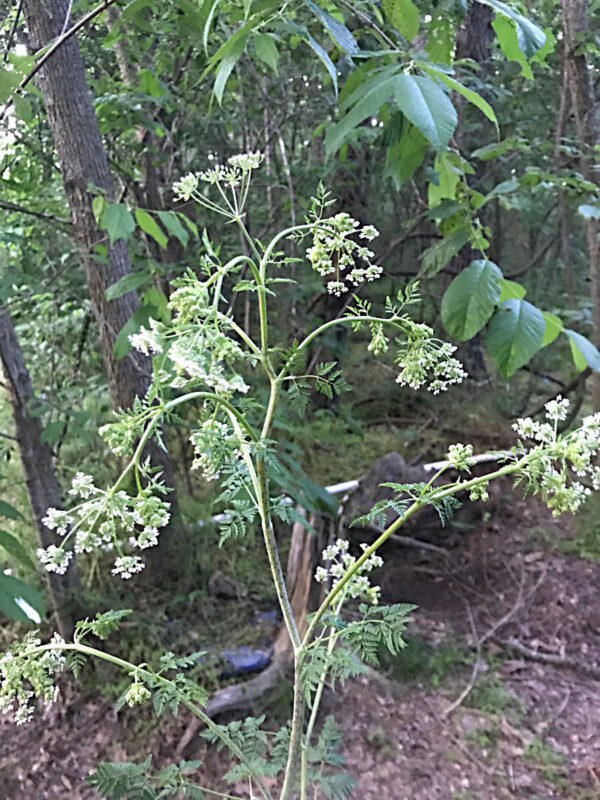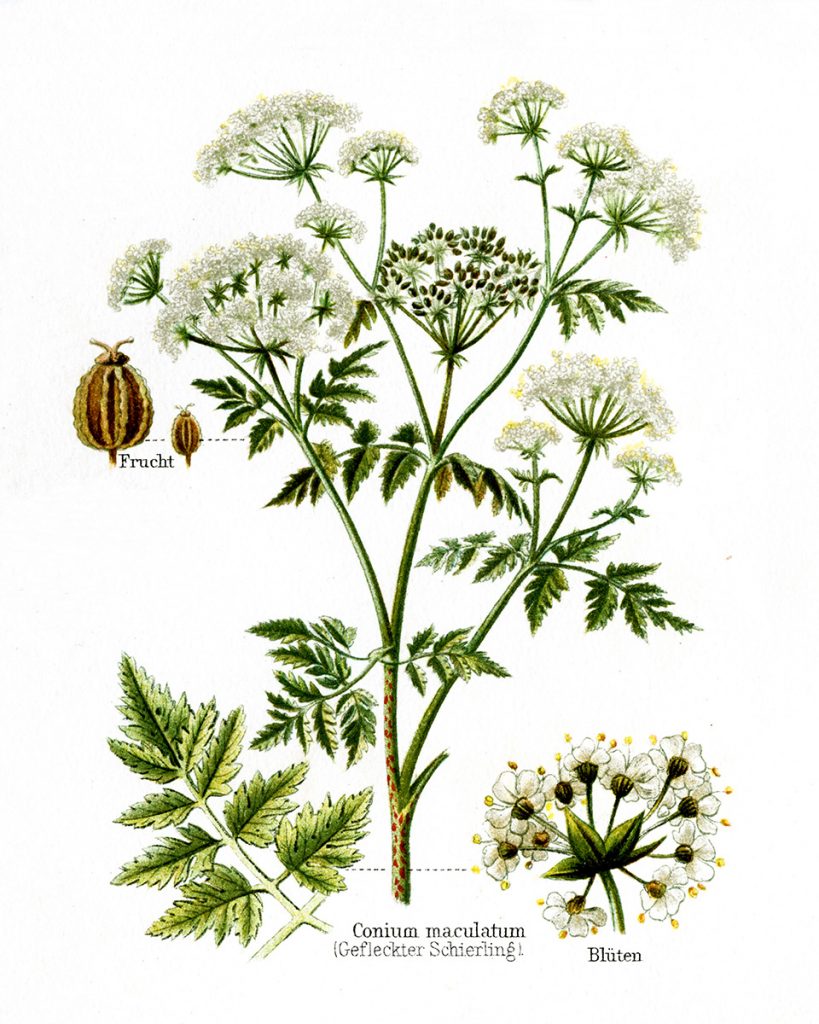
Poison hemlock is a highly toxic plant that is found in many parts of the world, including Europe, Asia, and North America. It belongs to the family Apiaceae, which also includes other poisonous plants like water hemlock and cowbane. Poison hemlock is a tall, erect plant that can grow up to 3 meters in height. It has a smooth, hairless stem that is usually green, but can have purple spots. The leaves of poison hemlock are fern-like and can be up to 50 cm long. The plant produces small, white flowers that are arranged in umbrella-shaped clusters during the summer months. Poison hemlock seeds are small, ridged, and have a distinct aroma that is often described as musty or earthy.
Poison hemlock is highly toxic to humans and animals. It contains a potent neurotoxin called coniine, which affects the central nervous system and can lead to paralysis and death. Hemlock poisoning can occur through ingestion, inhalation, or skin contact, and symptoms can include nausea, dizziness, vomiting, and respiratory failure.
The importance of distinguishing poison hemlock from other plants cannot be overstated. It is often confused with other plants that look similar to it, such as wild carrot, parsley, and Queen Anne’s lace, which are all members of the same family. The similarities in appearance between these plants make it difficult to tell them apart, which can lead to accidental poisoning. Wild carrot, parsley, and Queen Anne’s lace are edible plants, while poison hemlock is deadly. Mistaking one for the other can have grave consequences.
Identifying Characteristics of Hemlock
Poison hemlock, water hemlock, and cowbane are herbaceous plants that grow in wet areas and are highly toxic. The leaves of the plant are fern-like and can be up to 50 cm long. The stem of the plant is usually green or reddish-brown and can be smooth or hairy depending on the species. The flowers of hemlock plants are small and white and are arranged in umbrella-shaped clusters. The seeds of the plant are small and ridged, and can have a distinct aroma that is often described as musty or earthy.
These plants typically grow in moist, shaded areas such as wetlands, meadows, and along streams and rivers. Hemlock plants can tolerate a wide range of soil types, but they prefer to grow in soils that are rich in organic matter and have a neutral to slightly acidic pH.

Toxicity
The plant contains several toxic alkaloids, including coniine and gamma-coniceine, which can cause paralysis of the respiratory system and lead to death. The poison hemlock plant has been responsible for the deaths of many humans and animals throughout history.
The toxic effects can occur quickly after ingestion. The symptoms of poisoning can include confusion, dizziness, nausea, vomiting, tremors, seizures, and respiratory failure. In severe cases, the poison can lead to coma and death within a few hours.
It is important to note that all parts of the poison hemlock plant are toxic, including the leaves, stems, flowers, and seeds. The toxin in poison hemlock can also be absorbed through the skin or inhaled, so it is important to take precautions when handling the plant.
One of the dangers of poison hemlock is that it can be mistaken for other plants that are commonly found in the wild, such as wild carrot, parsley, and fennel. The plants can be similar in appearance, but poison hemlock can be distinguished by its smooth, hairless stem and distinctive musty odor.
If you suspect that you or someone else has been poisoned by poison hemlock, seek medical attention immediately. Treatment may include inducing vomiting, administering activated charcoal, and providing supportive care for respiratory failure and other symptoms.
Identification of Hemlock
Distinguishing poison hemlock from similar edible plants can be challenging, but there are a few key characteristics that can help you identify this dangerous plant.
Firstly, poison hemlock has a hairless stem that is smooth and hollow. It also has distinctive purple spots or streaks on the stem. These characteristics distinguish it from wild carrots, parsley, and fennel, which have hairy stems and are not hollow.
Secondly, poison hemlock has distinctive fern-like leaves that are finely divided and lacy. The leaves of wild carrot and parsley are also finely divided, but they have a more feathery appearance and are not as lacy as poison hemlock leaves.
Thirdly, poison hemlock has a musty or unpleasant odor, particularly when the leaves or stems are crushed. This odor is not present in other similar plants, making it a reliable characteristic for identification.
It is important to note that these characteristics should not be used in isolation to identify poison hemlock. It is always best to consult a plant identification guide or expert before consuming any wild plant. Additionally, it is recommended to avoid consuming any wild plant unless you are 100% certain of its identification.
Protection and Eradication
Protecting yourself from exposure to hemlock is important as it is a highly toxic plant that can be deadly if ingested, absorbed through the skin, or inhaled. Here are some steps you can take to protect yourself:
- Wear protective clothing: When handling or removing the plants, wear protective clothing such as gloves, long-sleeved shirts, and pants to prevent contact with your skin.
- Use proper equipment: Use appropriate tools, such as a hoe or weed trimmer, to remove the plants. Avoid using your hands or bare skin to touch or pull the plant.
- Avoid inhaling the plant: Wear a mask to avoid inhaling any dust or particles from the plant.
- Clean your tools and clothing: After handling, clean your tools and clothing thoroughly to prevent any potential exposure.
- Dispose of hemlock properly: Do not compost, as the toxins in the plant can remain active in the soil. Instead, dispose of it in a sealed bag and place it in the trash.
Now, let’s discuss steps to eradicate hemlock on a property:
- Identify the plant: Make sure you have correctly identified the plant. Hemlock can be easily mistaken for other similar plants, so it is important to use a plant identification guide or consult an expert.
- Remove the plant: Use appropriate tools, such as a hoe or weed trimmer, to remove the plant. Avoid using your hands or bare skin to touch or pull the plant. Make sure to remove the entire plant, including the roots.
- Monitor the area: After removal, monitor the area for any signs of regrowth. If any new plants appear, remove them immediately to prevent further spread.
- Consider using herbicides: If the infestation is severe, you may need to use herbicides to effectively eradicate the plant. Consult an expert or follow the herbicide manufacturer’s instructions carefully.
It is important to be positive you can identify this plant if you plan to make our Queen Ann’s Lace jelly recipe. The plants look similar so identification is extremely important.
Be sure and check out our other articles on our Natural Living blog.
FAQs:
Q: What are the identifying characteristics of Hemlock?
A: It can grow up to 10 feet tall. It has fern-like leaves and small, white flowers that grow in clusters.
Q: Is Hemlock toxic?
A: Yes, this is a highly toxic plant. It contains a poison called coniine, which can cause paralysis and even death if ingested.
Q: How can I identify Hemlock?
A: Hemlock can be identified by its distinctive fern-like leaves, which are arranged in an alternating pattern along the stem. The stem is smooth and hollow with purple spots, and the flowers are small and white.
Q: How can I protect myself from Hemlock poisoning, and how can I eradicate it from my property?
A: It’s important to wear gloves and protective clothing when handling Hemlock. To eradicate it from your property, you can cut it down and dispose of it carefully. However, it’s important to note that the plant’s roots are toxic and should be handled with caution. You may need to use herbicides or hire a professional to remove Hemlock safely.